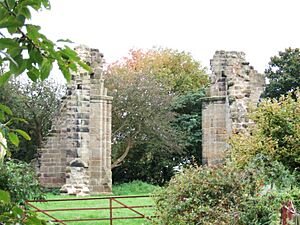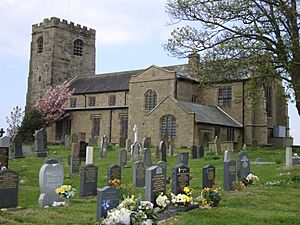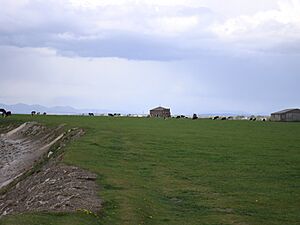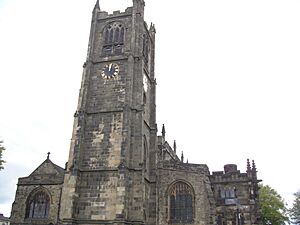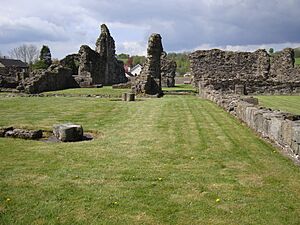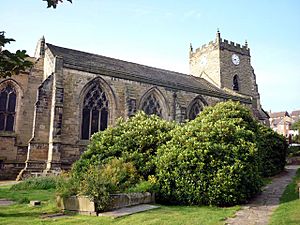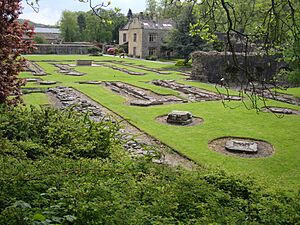List of monastic houses in Lancashire facts for kids
This article is about the old monastic houses in Lancashire, England. Monastic houses were special buildings where groups of people, like monks or nuns, lived together. They followed strict religious rules and dedicated their lives to prayer, study, and work. These places were very important in medieval times, acting as centers for learning, charity, and farming.
In Lancashire, many different types of monastic houses existed. These included abbeys (led by an abbot or abbess), priories (smaller houses often linked to a larger abbey), and friaries (where friars lived, who were different from monks because they often traveled and preached). Over time, many of these houses were closed down, especially during the 1500s when King Henry VIII dissolved them.
Here's a look at some of the monastic houses that once stood in Lancashire:
Contents
- Monastic Houses in Lancashire
- Barnoldswick Abbey
- Beaumont Grange
- Burscough Priory
- Cockerham Priory
- Cockersand Abbey
- Heysham Monastery
- Hornby Priory
- Lancaster Blackfriars
- Lancaster Greyfriars
- Lancaster Priory
- Lytham Priory
- Penwortham Priory
- Preston Greyfriars
- Sawley Abbey
- Staining Grange
- Tulketh Priory
- Upholland Priory
- Whalley Abbey
- Wyresdale Abbey
- Images for kids
- See also
Monastic Houses in Lancashire
Barnoldswick Abbey
Barnoldswick Abbey was home to Cistercian monks. These monks were known for living simple lives and often settling in remote areas. This abbey was founded on May 19, 1147. However, the monks moved to Kirkstall Abbey in Yorkshire just five years later, in 1152. After they left, Barnoldswick was used as a grange, which was like a large farm run by the monastery. Today, its remains are in a field called 'Monk's Royd'.
Beaumont Grange
Beaumont Grange was first home to Savignac monks. These monks were part of an order that later joined the Cistercians. It was founded around 1130. It was a large and important place. When the Savignac and Cistercian orders merged on September 17, 1147, the monks here became Cistercian.
Burscough Priory
Burscough Priory was a home for Augustinian Canons Regular. These canons were priests who lived together under a rule, similar to monks. The priory was founded around 1186 or 1190 by Robert Fitz Henry. It was dedicated to St Nicholas. Burscough Priory was closed down in 1536 during the Dissolution of the Monasteries.
Cockerham Priory
Cockerham Priory also housed Augustinian Canons Regular. It was a smaller house, known as a 'cell', connected to a larger abbey in Leicester. It was founded around 1207 or 1208. By the late 1200s, most of the canons had left, and a secular chaplain (a priest not part of a monastic order) was appointed. The priory was dissolved in 1477.
Cockersand Abbey
Cockersand Abbey started as a hospital dedicated to St Mary before 1184. It was founded by a hermit named Hugh Garth. Later, it became home to Premonstratensian Canons, who were also known as White Canons because of their white habits. It was made an abbey in 1192. The abbey was dissolved on January 29, 1539, and its land was later given to a private owner. Today, it is still privately owned.
Heysham Monastery
There is a suggestion that an early monastic settlement existed at Heysham. The church of St Peter, built in the 14th or 15th century, stands on this site. It includes parts that are much older, from before the Norman Conquest (around 800-950 AD). This suggests that religious activity has been happening here for a very long time.
Hornby Priory
Hornby Priory was a cell for Premonstratensian Canons, connected to Croxton Abbey. It might have started as a hospital between 1160 and 1172. The priory itself was likely founded around 1172. It was dedicated to St Wilfrid. Hornby Priory was dissolved in September 1538.
Lancaster Blackfriars
Lancaster Blackfriars was a home for Dominican Friars. Friars were different from monks because they often lived among people in towns and cities, preaching and helping the poor. The Dominicans were also known as 'Blackfriars' because of their black cloaks. This friary was founded in 1259 or 1260 by Sir Hugh Harrington. It was dissolved in 1539.
Lancaster Greyfriars
Lancaster also had a house for Franciscan Friars. These friars were known as 'Greyfriars' because of their grey habits. There is some evidence that a Franciscan house existed here, but its exact location and the dates it was founded and dissolved are not fully known.
Lancaster Priory
Lancaster Priory was home to Benedictine monks. The Benedictines are one of the oldest monastic orders. This priory was founded around 1094 by Earl Roger of Poictiers. It was an 'alien house', meaning it was dependent on a larger monastery in Séez, France. Lancaster Priory was dissolved in 1428.
Lytham Priory
Lytham Priory was another house for Benedictine monks. It was a 'cell' connected to Durham Cathedral. It was founded between 1189 and 1194 by Richard Fitz Rogers. The priory was dissolved in 1535 or 1534. The original building was demolished, and a country house was built on its site in the 17th century. It was dedicated to St Mary and St Cuthbert.
Penwortham Priory
Penwortham Priory was also a home for Benedictine monks. It was founded around 1104, thanks to the generosity of Warine Bussel. This priory was dissolved around 1535.
Preston Greyfriars
Preston Greyfriars housed Franciscan Friars Minor, Conventual. Like the Greyfriars in Lancaster, they wore grey habits and lived among the people. This friary was founded around 1256 or 1260 by Edmond, Earl of Lancaster. It was dissolved in 1539.
Sawley Abbey
Sawley Abbey was a home for Cistercian monks. These monks came from Newminster Abbey in Northumberland. The abbey was probably founded on January 6, 1147, by William de Percy. The monks likely arrived a year later. Sawley Abbey was dissolved in 1536. Today, its ruins are cared for by English Heritage.
Staining Grange
Staining Grange was a grange (a monastic farm) for Cistercian monks. It belonged first to Stanlow Abbey and then to Whalley Abbey. It was founded before 1240.
Tulketh Priory
Tulketh Priory was home to Savignac monks. It was founded on July 4, 1124, by Stephen, who later became King of England. However, the monks moved to Furness Abbey in Cumbria just three years later, in 1127.
Upholland Priory
Upholland Priory started as a chantry and collegiate chapel, which means it was a place for prayers and a college for priests. It was founded between 1307 and 1310. Later, in 1319, it became a priory for Benedictine monks or friars, founded by Walter Langton, who was a bishop. Upholland Priory was dissolved in 1536. Today, its remains are part of the Parish Church of St Thomas the Martyr.
Whalley Abbey
Whalley Abbey was a large and important house for Cistercian monks. The community of monks first lived at Stanlow Abbey in Cheshire, starting in 1172. They then moved to Whalley and founded the abbey there on April 4, 1296. Whalley Abbey was dissolved on March 10, 1537. Today, parts of the abbey are owned by the Anglican Diocese of Blackburn and the Catholic Church. It was dedicated to The Blessed Virgin Mary.
Wyresdale Abbey
Wyresdale Abbey was intended for Cistercian monks from Furness Abbey and Savigny Abbey. It was founded around 1193 or 1196. However, the monks later moved to Ireland. Traditionally, the site of this abbey is believed to be near the Abbeystead reservoir.
Images for kids
See also


